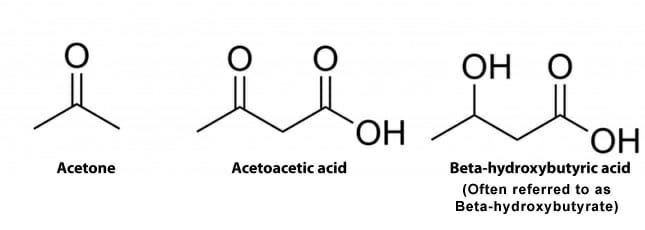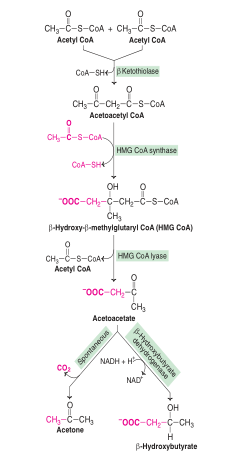Introduction:
Ketone bodies or simply ketones are organic compounds that serve as an alternative energy source for the body, particularly during periods of prolonged fasting or low carbohydrate intake. They are produced in the liver through a process called ketogenesis, primarily from fatty acids derived from stored fats.
During normal metabolic conditions, the body primarily relies on glucose as its primary source of energy. However, when glucose availability is limited, such as during fasting, prolonged exercise, or a low-carbohydrate diet, the body shifts its metabolism to utilize ketone bodies as an alternative fuel source.
They provide an alternative fuel source for the body, particularly the brain, to meet its energy needs when glucose availability is limited.
Types:
Acetoacetate
Acetoacetate is the first ketone body produced during ketogenesis in the liver
Beta-hydroxybutyrate (BHB)
Beta-hydroxybutyrate is the most abundant and physiologically significant ketone body. BHB can be utilized by various tissues, including the brain, heart, and skeletal muscles, as an energy source.

Source: https://biologydictionary.net/
Fig: Types of ketone bodies
Acetone
Acetone is a volatile ketone body that is a by-product of ketone metabolism. Acetone is primarily excreted from the body through breath and urine. It is responsible for the fruity odour sometimes detected in the breath of individuals in a state of ketosis.
Biosynthesis:
Many tissues use ketone bodies as an energy source when there is a shortage of glucose. Ketone bodies are produced by the liver from the oxidation of non-esterified or free fatty acids (FFAs).
Lipolysis
During periods of low glucose availability, stored triglycerides in adipose tissue are broken down into glycerol and free fatty acids through a process called lipolysis. The free fatty acids are released into the bloodstream and transported to the liver.
Fatty acid oxidation
In the liver, the free fatty acids are taken up and undergo beta-oxidation, a process in which fatty acids are sequentially broken down into two-carbon units called acetyl-CoA. This process generates NADH and FADH2, which can enter the electron transport chain and contribute to ATP production.
Formation of acetoacetyl-CoA
Two molecules of acetyl-CoA combine to form acetoacetyl-CoA through the action of the thiolase enzyme.
Formation of hydroxymethylglutaryl-CoA (HMG-CoA)
Acetoacetyl-CoA condenses with another molecule of acetyl-CoA, catalyzed by the enzyme HMG-CoA synthase, to form HMG-CoA.

Source: Satyanarayana, U., 2021. Biochemistry, 6e-E-book. Elsevier Health Sciences
Fig: Biosynthesis of ketone bodies
Conversion of HMG-CoA to acetoacetate
HMG-CoA is then cleaved by HMG-CoA lyase, resulting in the formation of acetoacetate. This step is irreversible and represents the entry point of ketone body formation.
Interconversion between acetoacetate and beta-hydroxybutyrate
Acetoacetate can be reduced to beta-hydroxybutyrate (BHB) through the action of beta-hydroxybutyrate dehydrogenase. This conversion occurs mainly in the liver but can also take place in peripheral tissues.
Utilization and transport of ketone bodies
Acetoacetate and beta-hydroxybutyrate are released into the bloodstream and transported to various tissues, including the brain, heart, and skeletal muscles. Acetoacetate can also be spontaneously decarboxylated to form acetone, which is excreted through breath and urine.
Regulation of Ketone Body Production:
Low insulin levels
Insulin levels decrease during fasting or a low-carbohydrate diet, promoting the breakdown of stored fats and increased fatty acid availability.
High glucagon levels
Glucagon stimulates the breakdown of glycogen and fatty acids, activating enzymes involved in ketone body production.
Increased fatty acid availability
Abundant fatty acids, from dietary intake or stored fats, provide the raw materials for ketone body synthesis.
Enzymatic regulation
Enzymes involved in ketone body synthesis are regulated by hormonal signals and metabolic intermediates.
Importance and Functions:
- Provide an alternative energy source when glucose is low.
- Support brain function and preserve muscle tissue.
- Enable metabolic flexibility and adaptation to different conditions.
- Have antioxidant effects and maintain redox balance.
- Influence appetite regulation and satiety.
- Modulate epigenetic modifications.
Clinical Implications and Applications:
- Ketogenic diet: Used for epilepsy and explored for other neurological disorders and cancer.
- Diabetes management: Ketone bodies can indicate diabetic ketoacidosis and low-carb diets may benefit type 2 diabetes.
- Weight management: Ketogenic diets may aid weight loss by suppressing appetite.
- Metabolic disorders: Ketone bodies provide an alternative energy source for certain metabolic disorders.
- Neurological conditions: Ketone bodies show promise in epilepsy and neurodegenerative disorders.
References:
- Satyanarayana, U., 2021. Biochemistry, 6e-E-book. Elsevier Health Sciences.
- Nelson, D.L., Lehninger, A.L. and Cox, M.M., 2008. Lehninger principles of biochemistry. Macmillan.
